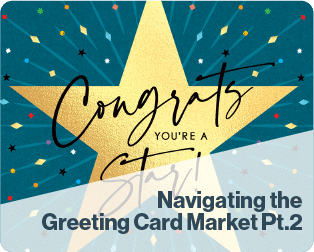Navigating the Greeting Card Market Part 2
Published on 20/07/2023Greeting Cards by Advocate Art illustrators Joanne Cave, Debbie Edwards, Nicola Evans, and Jane Ryder-Gray
Navigating the Greeting Card Market Part 2
Teacher: ITSme Society

In part 1, we discussed what makes greeting cards so special. In this digital age, the art of giving or receiving a physical card with a heartfelt, handwritten message is never lost on people.
Cards are designed like any other product – for a specific purpose. It’s far more than pasting an image onto a thick piece of paper and folding it in half, so try not to think of a card as a piece of art on a piece of paper, think of it as an image that encompasses a celebration, like welcoming a New Baby or wishing someone a wonderful Birthday. But then, just as important, the design must have a huge level of empathy between the sender and recipient, think of the differences between generations – two teenagers may prefer to send one another cards with images about going shopping or dancing at parties, whereas two elderly ladies may select cards embellished with a beautiful bouquet of flowers.
Once you understand that the image on a greeting card is a very purposeful design, you will increase your chances of being picked up by Greeting Card publishers and winning commissions. We’ve got a handy selection of facts, figures and useful tips that will be sure to help you land Greeting Card commissions. In this blog we will look at the facts and discuss how understanding of the Greetings Card trends and designs will help you tailor your designs.
Trends: Just like any fashion industry, card design occupies a narrow trend parameter. It can be very easy to be ahead of trend, or off trend altogether! Don’t try to be too innovative at first, it would be much better for you to do versions of existing compositions in your style then to try and reinvent what is fashionable in the Greeting Card industry. Imagine if you were a clothes designer, and you were asked to design a new line of girl’s clothes with no concept of what decade you were in. You can imagine how terrible the results would be. The same goes for Greeting Cards; you need to be aware of where the trend is and be right on it.

Character Design: You need to consider the sending situation when creating characters. Who is the design aimed at? Who is it intended to be from? This will affect a lot of things within your design, such as what the characters are doing, and what characters you include. E.g. A father sending a card to his son could have 2 characters that are the same type, such as a bear, fox or owl, but with one larger than the other, perhaps playing a game, this could create a loving scene, and the son can read his own interpretation of the card.
Face: When painting people into designs, try not to show them face on, as the customer buying the design needs to be able to put their own interpretation into it. They must be able to picture someone they know in the design (this is when getting specific with your target audience can come in useful). You can always obscure the face with an object or draw it loosely with less refined features so that it could appeal to more than one person.
For more free tips for how to improve your creative design skills subscribe to our ITSme Learning Newsletter!
Other News
Why Every Illustrator Portfolio Needs a Stand-Out Character (Yes, Even Yours)
When you’re thinking about our favourite stories as a child, we often think about the narrative, the themes, perhaps a particular quote that stood out, but the most memorable elements are always the characters. The reason the characters always stay in our minds is because they are the gateway to the narrative, and all of…
Trend Watch: YA Illustrated Covers
Over the past few years, illustrated covers have become a defining visual language in the Young Adult (YA) and New Adult (NA) book market. And no, this isn’t just a passing trend—it’s a design evolution powered by the viral force of #BookTok, #bookgirlies, and a growing appetite for genre-fluid storytelling. Hear what’s driving the…
Trend Watch: The Graphic Novel Boom
Every week we’ll be featuring a new article over on LinkedIn, in our new trend watch series! Graphic novels are having a moment—and it’s no passing trend. From classrooms to bestseller lists, graphic novels are dominating shelves and reading time across all ages. What was once seen as a niche format with a distinct, heavy-lined “comic book”…
Bologna 2025: A Week of Connection
By: Vicky Patoulioti, Talent Source Manager, ITSme This year’s Bologna Children’s Book Fair was one to remember. From early mornings to late evenings, our team Vicky, Bhavi, Ed, and Emily — were on the ground offering free portfolio reviews to artists from all over the world. Mornings kicked off with pre-scheduled reviews, while in the…
How to Beat AI and Catch the Client’s Eye
Illustration by Camipepe By: Edward Burns, CEO, ITSme As AI art tools become more sophisticated, it becomes more important to emphasize our value and status as authentic human artists. Crafting a great bio and portfolio is an excellent way to make an immediate impact. They should allow the client to get to know you in…
Be A Pro at Curating Your Portfolio!
You asked, and we listened! Be A Pro at Curating Your Portfolio; our new course is here! Learn all the secrets to crafting a standout portfolio with 4 Hours of Expert-Led Content! One of the biggest challenges you face in your illustration career is presenting your work in a way that catches the eye of…




